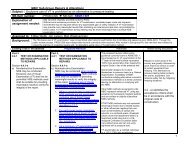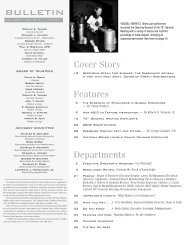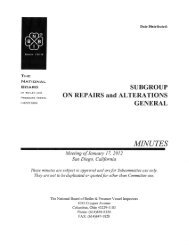bulletin - The National Board of Boiler and Pressure Vessel Inspectors
bulletin - The National Board of Boiler and Pressure Vessel Inspectors
bulletin - The National Board of Boiler and Pressure Vessel Inspectors
Create successful ePaper yourself
Turn your PDF publications into a flip-book with our unique Google optimized e-Paper software.
COVER STORY<br />
10<br />
<strong>of</strong> noise <strong>and</strong> smell, <strong>of</strong><br />
which the competing<br />
gasoline-driven cars<br />
were notably guilty.<br />
<strong>The</strong> Stanley brothers quickly received hundreds <strong>of</strong> <strong>of</strong>fers<br />
to buy the car. So they decided to make a hundred cars —<br />
the first quantity production <strong>of</strong> automobiles in the world!<br />
Before production was really underway, an <strong>of</strong>fer was<br />
made to buy the whole business, including the building<br />
<strong>and</strong> patents, which had not yet been applied for. So the<br />
first Stanley-designed cars sold to the public were built by<br />
a firm jointly owned by John Brisben Walker, publisher <strong>of</strong><br />
Cosmopolitan, <strong>and</strong> Amzi Lorenzo Barber, a paving<br />
machine manufacturer. <strong>The</strong>se two people soon had a<br />
parting <strong>of</strong> ways. Two companies resulted, Locomobile <strong>and</strong><br />
Mobile, <strong>and</strong> together made nearly 10,000 <strong>of</strong> these simple<br />
runabouts in four years.<br />
When a Locomobile, driven by F.O. Stanley, became the<br />
first car to climb Mount Washington, New Hampshire, in<br />
August 1899, it made headlines around the world. Of<br />
course, as soon as the popularity <strong>of</strong> these cars was<br />
noticed, everybody tried for a bit <strong>of</strong> the action. More than<br />
a hundred companies tried making steamers in the first<br />
decade <strong>of</strong> the twentieth century.<br />
BULLETIN: What does steam car technology involve?<br />
Mr. Nergaard: Like a steam power plant, a steam car can<br />
be divided into four major sections: the burner, the steam<br />
generator, the engine, <strong>and</strong> the auxiliaries. <strong>The</strong> burner<br />
releases the fuel’s energy in the form <strong>of</strong> heat. <strong>The</strong> steam<br />
generator conveys that heat to the working fluid for the<br />
engine. <strong>The</strong> engine converts some <strong>of</strong> the heat in the fluid<br />
to mechanical energy, which propels the car. And the<br />
NATIONAL BOARD BULLETIN/FALL 2003<br />
■ A st<strong>and</strong>ard Style No. 2<br />
Locomobile circa 1900,<br />
this two-passenger<br />
steam car was equipped<br />
with a rubber bucket,<br />
side lamps, gong,<br />
cyclometer, <strong>and</strong> a full set<br />
<strong>of</strong> tools for $750.<br />
auxiliaries h<strong>and</strong>le all<br />
the details needed to<br />
run the car, like<br />
pumping the working<br />
fluid <strong>and</strong> fuel into the generator <strong>and</strong> burner, respectively,<br />
<strong>and</strong> controlling various functions in the car.<br />
BULLETIN: Did steam technology improve along with<br />
steam car design?<br />
Mr. Nergaard: Yes, but not nearly as rapidly as it should<br />
have.<br />
<strong>The</strong> petroleum industry provided the most important<br />
improvements needed for early cars. Mineral oil-based<br />
lubricants, like superheated cylinder oil, <strong>and</strong> volatile fuels,<br />
like gasoline, both by-products <strong>of</strong> the kerosene industry,<br />
made small, efficient steam plants, as well as gasoline<br />
engines, possible.<br />
<strong>The</strong> development <strong>of</strong> the gasoline vaporizing burner<br />
produced a compact, powerful, easily controlled, <strong>and</strong> clean<br />
source <strong>of</strong> heat. This, in turn, allowed the building <strong>of</strong> very<br />
compact, efficient boilers. Coupled with a small version <strong>of</strong><br />
an engine, one obtained a power plant quite suited to the<br />
needs <strong>of</strong> a small motor carriage. <strong>The</strong> early Locomobile<br />
only weighed 500 pounds, with full tanks, water, <strong>and</strong> fuel<br />
for about 30 miles.<br />
■ <strong>The</strong> “St<strong>and</strong>ard Gasoline Burner” (left) was used with the majority <strong>of</strong><br />
Locomobiles, while the “Reverse Burner Complete” had an asbestoslined<br />
casing, pilot light, generator, <strong>and</strong> regulator.








